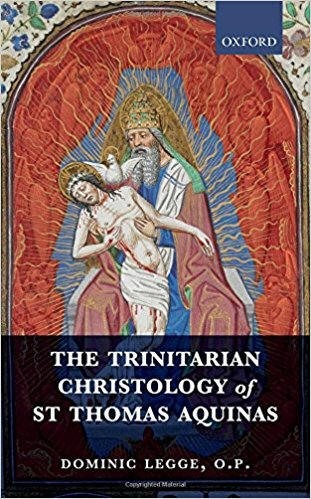Book Review
The Trinitarian Christology of St Thomas Aquinas
by Dominic Legge, O.P.
Oxford University Press
ISBN:
978-0198794196
 The
sheer importance of this work lies in our Christian belief that the
doctrines of the Trinity and Incarnation are central to our faith.
Aquinas, says the author, roots his doctrine firmly within his doctrine of
the Trinity. To put it simply, belief in the Trinity is not an optional
extra for the Christian. It is central to our following of Christ.
The
sheer importance of this work lies in our Christian belief that the
doctrines of the Trinity and Incarnation are central to our faith.
Aquinas, says the author, roots his doctrine firmly within his doctrine of
the Trinity. To put it simply, belief in the Trinity is not an optional
extra for the Christian. It is central to our following of Christ.
As Christians, we believe that God is three distinct Persons. The Son eternally proceeds from the Father and the Holy Spirit proceeds from both Father and Son. One God, three Persons. Aquinas follows the Tradition in his teaching on the doctrine of the Incarnation: the Holy Trinity is the efficient cause that unites the divine nature of the Second Person of the Trinity with the human nature of Jesus. There is no confusion of nature: Jesus is both fully human and fully divine. The reason for the Incarnation is the restoration of of God's fallen creation. Man is created in the image of God and the only one who can restore man to his former glory is God Himself.
The doctrines of the Trinity and Incarnation are thus supportive of each other, says the author. Indeed, the Incarnation can only be understood in Trinitarian terms. All this is very different from the separatist notions of modernist theologians like Rahner. The Son's identity can only be realized by means of His relationship with the Father and Holy Spirit.
What Legge demonstrates here is that for Aquinas, indeed for all orthodox Christians, the relationship between belief in the Trinity and in the Incarnation is "symbiotic" in that they support each other.
At the beginning of the book, it is shown that for Aquinas, the Son's Incarnation is Trinitarian. Salvation history is replete with Trinitarian images. Think of the Baptism of Jesus, or the Transfiguration or the death on Calvary. The Church teaches that created grace is Three divine Persons dwelling in our souls.
The visible mission of the Incarnation is manifested at Christ's Baptism, Transfiguration, at Pentecost and elsewhere. These manifestations are Trinitarian. Beyond these visible missions, we have the invisible ones including the divine indwelling in souls sanctified by grace. This sanctification conforms the human souls to the likeness of the Trinity. In the divine indwelling, the Father, Son and Holy Spirit are really present. With the Father, the Son sends the Spirit upon His Church.
In the latter part of the book, Legge shows that for Aquinas the Spirit's invisible mission to the Son accounts for the Son's gift of grace, including the Beatific Vision and prophetic knowledge. We know that the Spirit was there with Jesus at the annunciation, from our reading of scripture. But He was there throughout the life of Christ.
The book is at times not an easy read. But it is an important work. I read somewhere that Von Balthasar put on ear plugs during the lectures on scholastic theology. If he had not done so, perhaps he would not have ended up wondering if Jesus knew who He was.
At a time of heightened crisis in the Church, it is important for the laity to form themselves in accordance with orthodox Catholic theology. As such, this work is of immense importance.
Reviewed by Pravin Thevathasan
